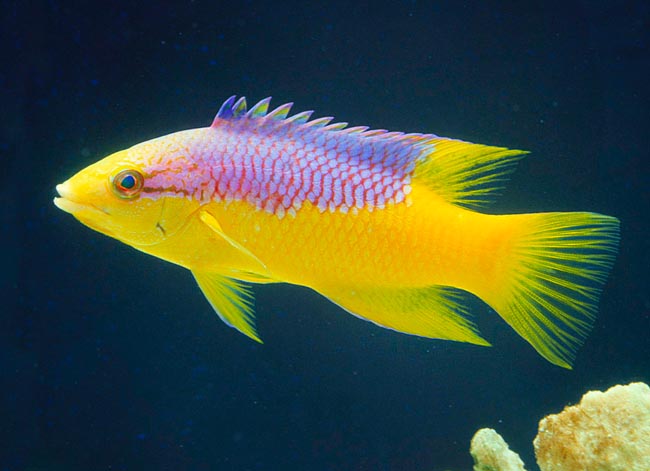Family : Labridae

Text © Giuseppe Mazza

English translation by Mario Beltramini
Bodianus rufus is recognized prima facie due to the vinous spot on the yellow body © Giuseppe Mazza
The Spanish hogfish (Bodianus rufus Linnaeus, 1758), belongs to the class of the Actinopterygii, the ray-finned fishes, to the vast order of Perciformes and to the family of Labridae.
The name of the genus comes from the Portuguese “bodiano, pudiano” = modesty, seen that the fore part of the back reddens with vinous spots.
The name of the species comes from the Latin “rufus” = pale red, always referring to the typical spot that stands out on the yellow body.
Zoogeography
It is common in the whole Gulf of Mexico, Florida included, and in the Caribbean Sea, but also along the Atlantic Brazilian coasts. Just to cite some locations, we find it in the Bahamas, Cuba, Haiti, Dominican Republic, Puerto Rico, Virgin Islands, Guadeloupe, Martinique, Barbados, Mexico, Guatemala, Honduras, Nicaragua, Costa Rica, Panama, Colombia and Venezuela.
Ecology-Habitat
It lives in the madreporic formations up to about 70 m of depth.
Morpho-physiology
It may reach the 40 cm, and the body, compressed on the sides, with solid jaws, somewhat reminds the Mediterranean wrasses belonging to the genus Symphodus. The dorsal fin has 12 spiny rays and 9-11 soft, the anal 3 spiny rays and 11-13 soft and both end pointed, as well as the unarmed ventral ones. The pectoral fins count 15-16 soft rays and the caudal is blunt. The livery is yellow with scales having red border, more evident in the typical vinous zone, often tending bluish violet, starting from the eye and extending from the sides up to the back.
Ethology-Reproductive Biology
The Bodianus rufus mainly nourishes of crustaceans, molluscs and echinoderms, like sea urchins, ophiurans and starfishes. The young predate small organisms, and, like the Labroides, clean up various fishes from their ectoparasites.

At home in the Caribbean, reaches 40 cm and for various reasons recalls Mediterranean wrasses © Giuseppe Mazza
This is a hermaphrodite protogynous species: the animals fished when young are, therefore, all females, but when they exceed the 17-18 cm, in less than 10 days they may transform in males. By the end, they form small harems of females with a dominant male, but the reproduction is pair matter and not, as at times is the case, a group ceremony. The pelagic eggs are fecundated by dusk and not rare are the instances of hybridization cases with the Bodianus pulchellus.
The big specimens are often consumed by the local populations, oblivious to the ciguatera risk, an alimentary intoxication related to the presence of poisonous organisms in their diet, and even if having a splendid livery, the young are little required by the aquaria market. In fact, even if they adapt well to the captivity life, they become aggressive when growing.
The populations double in 1,4-4,4 years and the vulnerability index of the species is presently moderate: 39 per 100.
Synonyms
Labrus rufus Linnaeus, 1758; Bodianus bodianus Bloch, 1790; Lutjanus verres Bloch, 1791; Labrus semiruber Lacepède, 1801; Harpe caeruleoaureus Lacepède, 1802; Bodianus blochii Lacepède, 1802; Bodianus brachyrhynus Miranda Ribeiro, 1918.
→ For general information about FISH please click here.
→ For general information about BONY FISH please click here
→ For general information about CARTILAGINOUS FISH please click here.
→ To appreciate the BIODIVERSITY of BONY FISH please click here.
→ To appreciate the BIODIVERSITY of CARTILAGINOUS FISH please click here.
